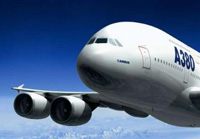
The world's largest passenger plane, the Airbus A380, successfully took off on its maiden flight Wednesday, a milestone for aviation and for the European aircraft-maker's battle with American rival Boeing Co.
The double-decked, 308-ton plane landed successfully to applause at 2:22 p.m (8:22 a.m. EDT) after a flight of nearly four hours. About 30,000 spectators watched the white plane with blue tail take off and touch down, 101 years after the Wright brothers achieved the first controlled, sustained flight.
Before it landed, its front lights shining, the A380 did a slow flyover above the airport in Blagnac, southwest France, where it had taken off at 10:29 a.m. (4:29 a.m. EDT).
The plane was carrying a crew of six and 22 tons of on-board test instruments. Its first flight was expected to last about four hours.
"The takeoff went perfectly," Alain Garcia, an Airbus engineering executive, said on LCI television.
The plane was likely to stay within 100 miles of the airport in Blagnac, a suburb of Toulouse in southwest France. It was beaming back real-time measurements to Airbus headquarters at Blagnac.
There were cheers and applause as the white jet with a blue tail — its engines surprisingly quiet — picked up speed down the runway and lifted smoothly into the blue skies. Fire trucks were stationed alongside the runway as a precaution.
Airbus chief test pilot Jacques Rosay, flight captain Claude Lelaie and four crew members — who all wore orange flight suits — were taking no chances. Airbus had said they would be wearing parachutes during the first flight, in accordance with company policy. A handrail leads from the cockpit to an escape door that can be jettisoned if the pilots lose control of the plane.
The flight capped 11 years of preparation and $13 billion in spending. Spectators camped out by the airport to be there for what some said was Europe's biggest aviation event since the first flight of the supersonic Concorde in 1969.
The A380, with a catalogue price of $282 million, represents a huge bet by Airbus that international airlines will need bigger aircraft to transport passengers between ever-busier hub airports.
But some analysts say signs of a boom in the market for smaller wide-body planes, such as Boeing's long-range 787 "Dreamliner," show that Airbus was wrong to focus so much time and money on its superjumbo.
The president of Boeing's French subsidiary, Yves Galland, said he watched the televised takeoff and "shared the emotion of the people of Airbus."
But, speaking on LCI television, he also reiterated Boeing's argument that Airbus has overestimated the market for jumbo jets, which he called "quite weak."
"We don't have the same analysis of the market as Airbus," he said.
Just this week, Air Canada said it had firm orders for 32 new Boeing jets, including 14 787s, with a list value of about $6 billion, and Air India announced plans to order 50 Boeing jets worth $6.8 billion. Air India wants 27 of the 787s, which will carry up to 257 passengers and have a list price of $120 million, boosting total orders and commitments for the plane to 237. The 787, which was launched a year ago, is scheduled to enter service in 2008.
So far, Airbus has booked 154 orders for the A380, which it says will carry passengers 5 percent farther than Boeing's longest-range 747 jumbo at a per-passenger cost up to one-fifth below its rival's.
But Airbus has yet to prove that it can turn a profit on its superjumbo investment, a third of which came from came from European governments.
Airbus, a unit of European Aeronautic Defence and Space Co., is also planning to bring its own mid-sized jetliner, the A350, into service in 2010 — two years after the Boeing 787.
Aviation experts say risks were very slim on the A380 maiden test flight since a plane's aerodynamic characteristics are already well known before it takes off, thanks to years of computer modeling and wind-tunnel tests.
Problems are more likely, but still very rare, later in the test-flight program, when the pilots deliberately take the plane to its limits. An Airbus A330 prototype crashed here in July 1994, killing chief test pilot Nick Warner and six others as they conducted a simulated engine failure exercise.
The test-flight program is likely to finish before the A380 enters service for Singapore Airlines in mid-2006, Airbus said — about three months behind the previous schedule.
Part of the delay is down to the superjumbo's struggle with a weight problem that consumed months of engineering time and most of the program's $1.88 billion in cost overruns. Competitive pressure on airlines to offer plusher business-class seating tightened the squeeze — compounded by the A380's sheer scale.
(CRI.com via AP April 28, 2005)
|

